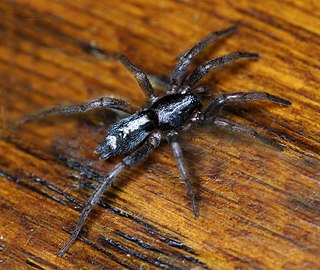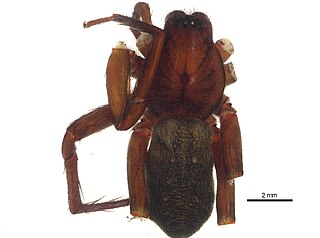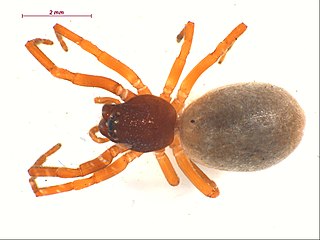
Tengellidae is a former family of spiders that has been merged into the family Zoropsidae. Genera formerly placed in Tengellidae now in Zoropsidae include:

Zoropsidae, also known as false wolf spiders for their physical similarity to wolf spiders, is a family of cribellate araneomorph spiders first described by Philipp Bertkau in 1882. They can be distinguished from wolf spiders by their two rows of eyes that are more equal in size than those of Lycosidae.

Coneweb spiders (Diguetidae) are six-eyed haplogyne spiders that live in tangled space webs, fashioning a cone-like central retreat where they hide and lay eggs. It is a small family, containing only two genera with fifteen species and is confined to the New World, preferring deserts. Members of the genus Diguetia usually build their webs in shrubs or between cactus pads. They have the same eye arrangement as the venomous recluse spiders, but none are known to be harmful to humans.

Cryptachaea is a genus of spiders in the Theridiidae family.
Camillina is a genus of ground spiders that was first described by Lucien Berland in 1919. They are very similar to sister genus Zelotes.

Ebo is a genus of running crab spiders that was first described by Eugen von Keyserling in 1884.
Dysderina is a genus of goblin spider.

Herpyllus is a genus of ground spiders first described by Nicholas Marcellus Hentz in 1832.
Zorodictyna is a genus of spiders in the family Udubidae native to Madagascar. It has been described as an intermediate genus between Zoropsidae and Dictynidae, though it is now placed in Udubidae. This genus was originally placed in the family Zoropsidae, but it has been reassigned several times since. In 1967, Lehtinen moved it to Miturgidae. In 1999, it was moved back to Zoropsidae, and in 2015, it was moved to Udubidae.
Campostichomma is a genus of spiders in the family Udubidae native to Sri Lanka. Many of its species were moved to either Griswoldia or Devendra. This genus was originally placed in the family Agelenidae. It was moved to Miturgidae in 1967, to Zoropsidae in 1999, then to Udubidae in 2015.
Segestrioides is a genus of South American coneweb spiders that was first described by Eugen von Keyserling in 1883. Originally placed with the recluse spiders, it was moved to the coneweb spiders in 1983.
Pseudodysderina is a genus of spiders in the family Oonopidae. It was first described in 2013 by Platnick, Berniker & Bonaldo. As of 2017, it contains 8 species, all found in South America.

Titiotus is a genus of American false wolf spiders that was first described by Eugène Louis Simon in 1897.
Eilica is a genus of ground spiders that was first described by Eugen von Keyserling in 1891.
Otiothops is a genus of palp-footed spiders that was first described by W. S. MacLeay in 1839.

Anachemmis is a genus of North American false wolf spiders that was first described by Ralph Vary Chamberlin in 1919. It was briefly synonymized with Titiotus, but was reconfirmed as its own distinct genus in 1999.

Socalchemmis is a genus of North American false wolf spiders that was first described by Norman I. Platnick & D. Ubick in 2001. The genus name comes from a shortening of the phrase "Southern Californian Chemmis", as the genus was discovered in California.

Meriola is a genus of araneomorph spiders in the family Trachelidae, first described by Nathan Banks in 1895.

Trachelopachys is a genus of South American araneomorph spiders first described by Eugène Simon in 1897. Originally placed with the Corinnidae, it was moved to the Trachelidae in 2014.









